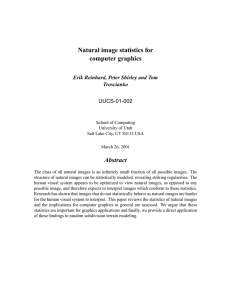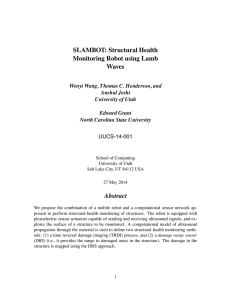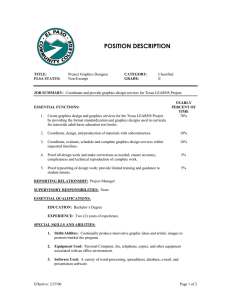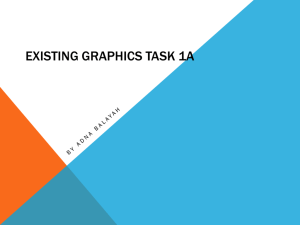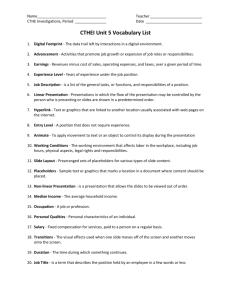01_introduction - Computer Science and Computer Engineering
advertisement
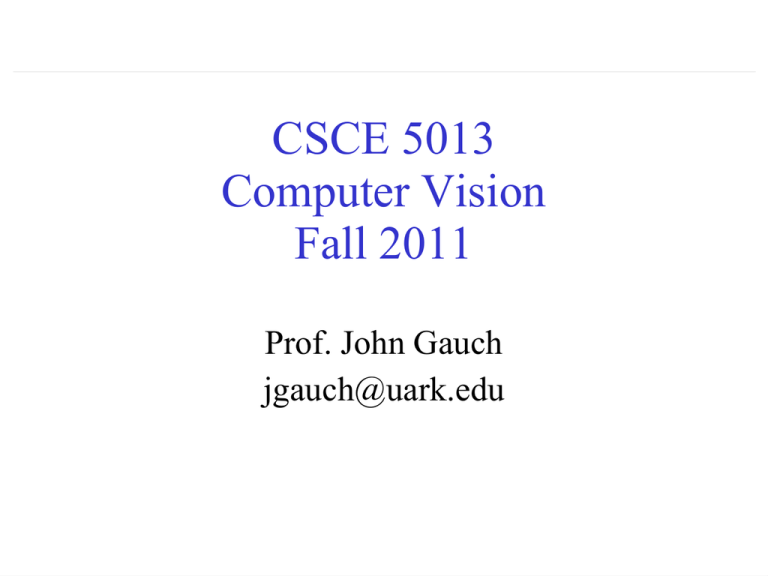
CSCE 5013 Computer Vision Fall 2011 Prof. John Gauch jgauch@uark.edu 01 - Introduction • • • • Overview Application Areas History Course Objectives Overview • Computer vision is the process of extracting useful information from digital images – Finding objects of interest in images – Properties of objects (size, shape, color) – Recognition of objects • Computer vision is also known as machine vision, robot vision, computational vision, or image understanding Overview • The fundamental problem of computer vision is that multiple models could fit the image data – Fitting a line equation to set of 2D points – Calculating 3D coordinates from 2D images • Hence we must select the best model that fits the data given the time/space constraints of the application Overview • Computer vision is closely related to three other research areas: – – – – Image processing (image => image) Computer vision (image => model) Computer graphics (model => image) Computational geometry (model => model) Application Areas • Automated inspection – CV is used to look for defects in manufactured parts and to assist in automated assembly Application Areas • Navigation – CV is used to guide a car or robot along roads or paths while avoiding obstacles Application Areas • Computer graphics modeling – CV is used to generate natural looking models that bend and move like real objects Application Areas • Security and surveillance – CV is used to watch areas of interest to detect suspicious activities in restricted areas Application Areas • Medical applications – CV is used to locate, identify and quantify abnormal features in medical images and assist in treatment Application Areas • Human Biometrics – CV is used to recognize people via face or fingerprint recognition History • Computer vision is a well established area of computer science and engineering – First attempts to model blocks world images were made at MIT in the 1960s – In the 1970s early computer vision methods made use of AI techniques to reason about line drawings – In the 1980s attempts to “understand everything” in an image were outperformed by task specific techniques History – The focus in the 1990s moved towards more physics based image modeling and real time applications such as video content analysis – In the 2000s we have seen computer vision methods mature and become widespread in other areas such as computer graphics – In the 2010s we will see even wider use of computer vision applications making use of FPGAs and GPUs and mobile devices Course Objectives • Goal of this class is to learn the fundamental techniques used in computer vision – – – – – Mathematical tools and techniques Algorithms and data structures Existing computer vision software Developing CV applications in C++ Reading current research literature Course Objectives • The remainder of this class we will focus on the fundamentals of computer vision – Image formation – how digital images are captured and how this knowledge of the scene can be used – Image processing – survey of basic techniques to manipulate images prior to detailed analysis – Feature detection – methods to extract geometric, chromatic or textural features from images Course Objectives – Image segmentation – methods to partition an image into visually sensible regions – Feature-based alignment – how image features can be used to align large collections of images – Motion estimation – techniques for measuring camera and/or object motion in image sequences – Emerging techniques – discussion of recent trends in computer vision and future applications



